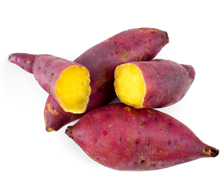
- Address : P.O. Box 11, Gannoruwa rd, Peradeniya, Sri Lanka
- E- Mail : director.hordi@doa.gov.lk
- Telephone :(+94) 081-2388011-12-13
- Fax :(+94) 081-2388234

Sweet Potato
Ipomea batatas
Originated in southern American Tropical countries. Cultivated throughout the year with irrigation easy management due to low input requirement, short duration and low pests and disease problems.
Released Varieties
- Wariyapola Red
- CARI-9
- CARI 273
- CARI 426
- Wariyapola White
- Shanthi
- Chithra
- Gannoruwa White
- Ama
- Dawala
- HORDI Malee
- Ranabima
Climatic requirements/ Areas suitable for cultivation
Can cultivate throughout the country except arid zone temperature in between 20-40.
Soil
Sandy/ loam soil with good drainage is suitable.
Cutting requirement
For 1 ha – 55,000 – 60,000 cuttings.
Nursery Management
Nursery has to be practice for every 5 season to increase vigor. Maintain nursery for tuber planting and get cuttings from the tubers from the nursery for field planting.
Land preparation
Plough the land about 25 cm depth. Hence Soil aeration and good drainage is facilitated.
Planting
However, vegetative growth is high in yala with good irrigation.
Spacing
1) In ridge and farrow system – 90 cm distance within farrow .keep 20 cm distance within plants.
2) In beds – Beds are prepared 6ocm width and keep 20 cm within plants.
Fertilizer
Add organic fertilizer. Apply inorganic fertilizer 2 weeks and 6 weeks after planting.
Inorganic fertilizer
Time of Application | Urea Kg/ha | TSP Kg/ha | MOP Kg/ha |
Basal(2weeks after planting | 60 | 120 | 120 |
Top Dressing(6 weeks after planting) | 60 | – | 60 |
Water supply
At the crop initial growth stage water supply is important.
Excess water reduces tuber production
Weed Control
It is important to remove weeds at early stage of the crop, to reduce plant competition.
Pest Management
Crop rotation, on time harvesting and removing of debries.
Sweet potato weevil is the most harmful pest.
Disease Management
Diseases which affect to the yield of sweet potato have not been reported so far in Sri Lanka. Root rot diseases can be caused by rare soil-borne fungal species.
Causal organism: This is caused by Fusarium spp., which live in the soil.
Symptoms
Leaves turn to the Yellowing and then can see the wilting of vines and rotting of roots.
Management
Remove diseased plants from the field along with soil.
Harvesting
Recommended varieties can be harvested at 3 to 4 months .Maturity can be identified by secretions of from damaged place of vine. If tubers are immature latex production is high.
Yield
15-25 t/ha
